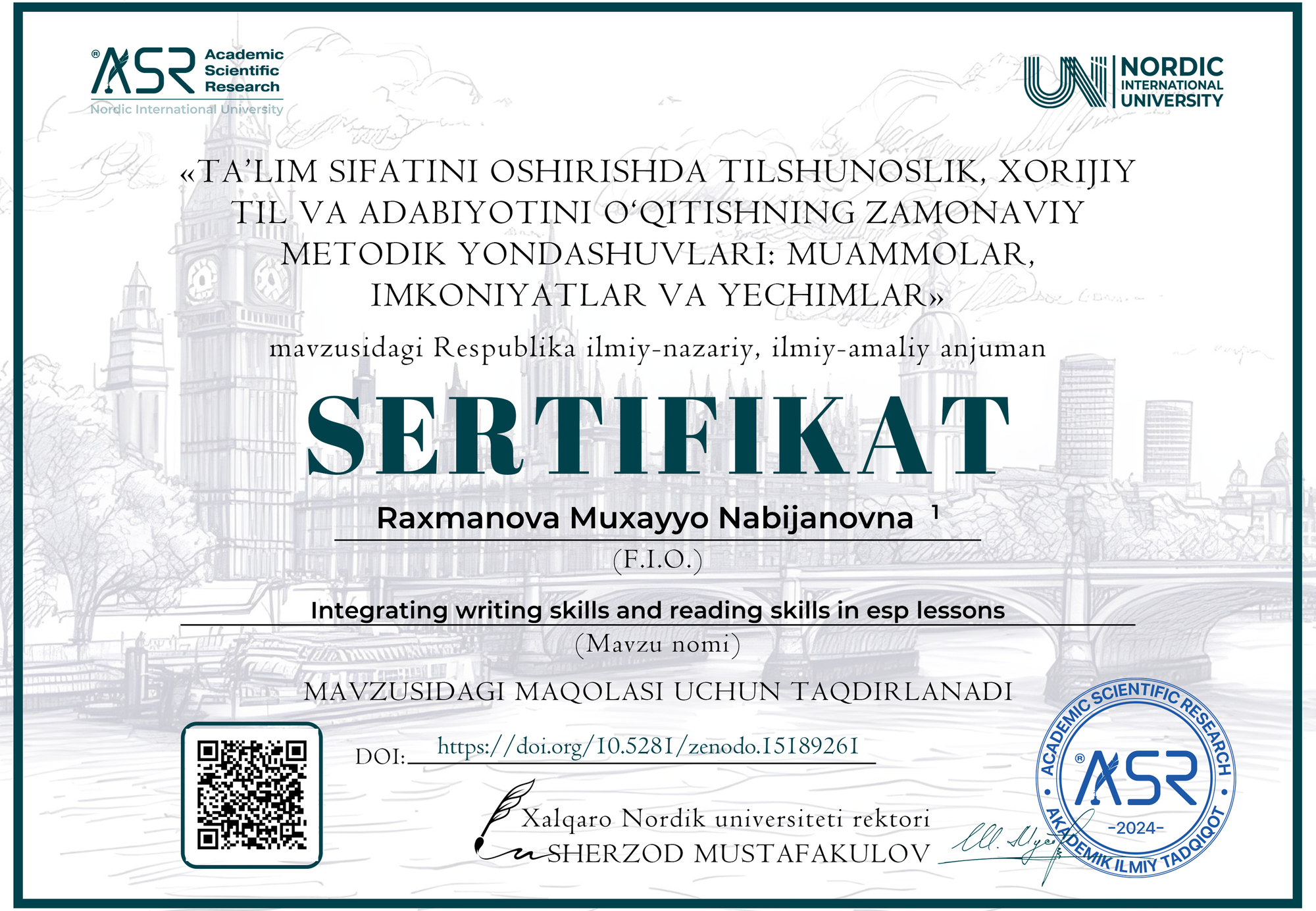Raxmanova Muxayyo Nabijanovna 1

DOI: https://doi.org/10.5281/zenodo.15189261
Google scholar: https://scholar.google.com/scholar?hl=ru&as_sdt=0%2C5&q=%22INTEGRATING+WRITING+SKILLS+AND+READING+SKILLS+IN+ESP+LESSONS%22&btnG=
Zenodo community: https://zenodo.org/records/15189261
Nordic_press journal: https://research.nordicuniversity.org/index.php/nordic/article/view/2307
MAQOLANI YUKLAB OLISH
SERTIFIKATNI YUKLAB OLISH
REVIEW:
The article by Muxayyo Nabijanovna Rakhmanova offers an insightful exploration into the integration of writing and reading skills within the context of English for Specific Purposes (ESP) education. This research focuses on enhancing students' language proficiency by utilizing both reading and writing activities, an approach that emphasizes the symbiotic relationship between these two critical skills in academic and professional settings. Rakhmanova’s study is relevant in light of the increasing demand for specialized language proficiency within fields such as engineering, business, and the sciences.
Key Strengths:
One of the key strengths of this article is its comprehensive examination of the theoretical foundations that support the integration of reading and writing skills. The author effectively highlights the interdependent nature of these skills, stressing that writing in a specialized field often requires an in-depth understanding of genre-specific texts. Conversely, reading specialized content enhances vocabulary acquisition and comprehension, which are crucial for effective writing. The paper presents a well-reasoned argument for the reciprocal benefits of integrating reading and writing instruction, emphasizing how this approach prepares learners for real-world communication within their professional domains.
Relevance and Context:
The paper begins by providing a valuable overview of the growing significance of ESP in contemporary language education, particularly in Uzbekistan’s educational landscape. The author notes that as global mobility and scientific communication increase, English has become the lingua franca of international discourse, further underscoring the importance of effective language skills. This context is especially relevant as more institutions focus on offering specialized language instruction tailored to specific disciplines, such as technical English for engineering students or business English for aspiring professionals.
The article’s focus on reading and writing integration is particularly pertinent given the complex nature of language use in professional fields. The ability to comprehend complex texts and articulate one’s thoughts through writing are indispensable skills in both academic and workplace settings. Rakhmanova addresses how an integrated approach fosters both cognitive and discursive skills that are essential for professional success, making this study a crucial contribution to the field of ESP education.
Methodology and Practical Application:
Rakhmanova employs a blend of theoretical and practical insights to discuss the integration of reading and writing in ESP courses. The paper refers to various models and theories that advocate for a holistic approach to language teaching, encouraging the synthesis of reading and writing tasks. The inclusion of authentic texts, such as technical reports, academic journals, and industry-specific materials, is particularly notable. By engaging students with real-world texts, the author suggests that learners can better develop domain-specific vocabulary and gain insights into the rhetorical structures commonly found within their respective fields.
One of the article’s most valuable aspects is its emphasis on how reading activities help students build the necessary background knowledge for effective writing. By analyzing specific genres of texts, students are not only exposed to the vocabulary and terminology needed for specialized writing but also learn about the conventions and stylistic features that shape professional communication. This integration facilitates a deeper understanding of both the content and the structure of texts, thus improving the overall writing skills of learners.
Implications for Teaching Practice:
The article has significant implications for ESP educators. By proposing an integrated approach to teaching reading and writing, the author advocates for more collaborative and learner-centered instructional methods. Rakhmanova’s discussion of teaching strategies, such as task-based learning and text-type analysis, provides practical tools for instructors to design lessons that develop both reading and writing skills simultaneously. These recommendations are particularly valuable for instructors working within technical and specialized fields, where students may often struggle with understanding complex materials and articulating their thoughts in writing.
Moreover, the study calls for the inclusion of authentic texts in ESP curricula, which aligns with current best practices in language teaching. The integration of such texts ensures that students are exposed to real-world language use, making their learning experience more relevant and applicable to their future careers. This approach also enhances students’ critical thinking and analytical abilities, as they engage with materials that require interpretation and synthesis.
Conclusion:
Rakhmanova’s article provides a thorough and insightful analysis of the integration of reading and writing skills in ESP education. The research effectively argues that the synergy between reading and writing enhances both language proficiency and disciplinary literacy, thus equipping students with the skills they need for academic and professional success. The study’s emphasis on authentic texts, task-based learning, and a learner-centered approach makes it highly relevant for educators in ESP contexts.
In conclusion, this research makes a significant contribution to the ongoing conversation about best practices in ESP education. It not only underscores the importance of integrating reading and writing but also provides a framework for implementing this approach in a way that supports students’ academic and professional goals. As ESP courses continue to evolve, the strategies outlined in this study will undoubtedly play a key role in shaping the future of language instruction in specialized domains.



